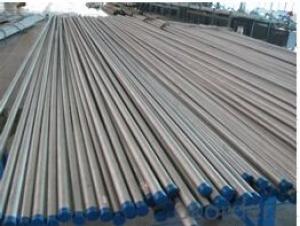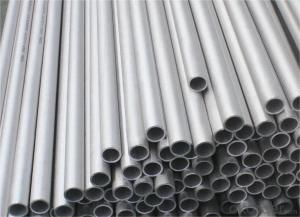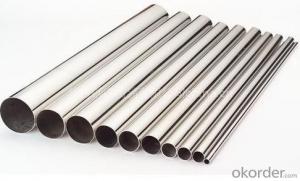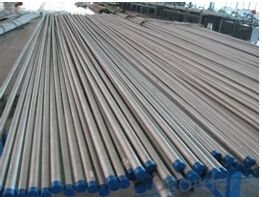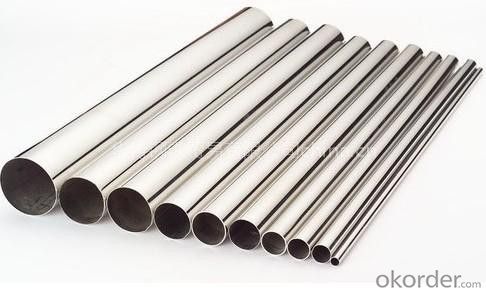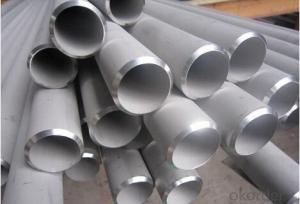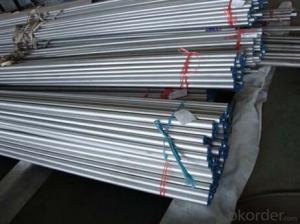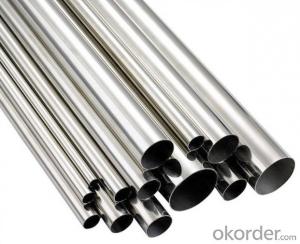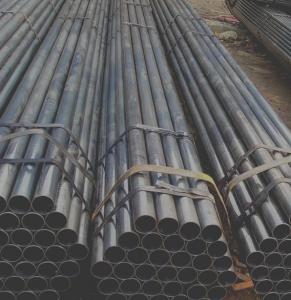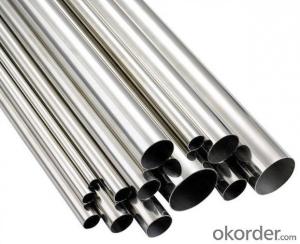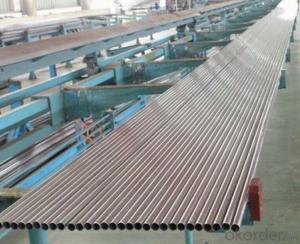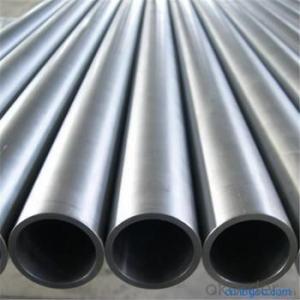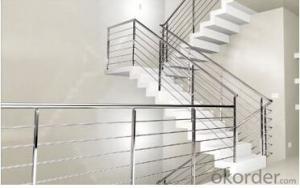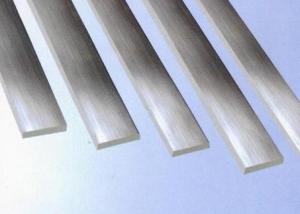Heat Exchanger Stainless Steel Pipe TP316 ASTM A213
- Loading Port:
- Ningbo
- Payment Terms:
- TT OR LC
- Min Order Qty:
- 1 m.t.
- Supply Capability:
- 5000 m.t./month
OKorder Service Pledge
OKorder Financial Service
You Might Also Like
1、Structure of Heat Exchanger Stainless Steel Pipe TP316 ASTM A213 Description:
Stainless Steel are corrosion resistant and can be built to meet various industrial, pharmaceutical, food, dairy, and beverage requirements. Other material and alloys including (Hastelloy, AL-6XN), titanium, copper-nickel alloys, copper, steel, carbon steel and brass are also available.
2、Main Features of Heat Exchanger Stainless Steel Pipe TP316 ASTM A213:
• High manufacturing accuracy
• High strength
• Small inertia resistance
• Strong heat dissipation ability
• Good visual effect
•Reasonable price
3、Heat Exchanger Stainless Steel Pipe TP316 ASTM A213 Images:

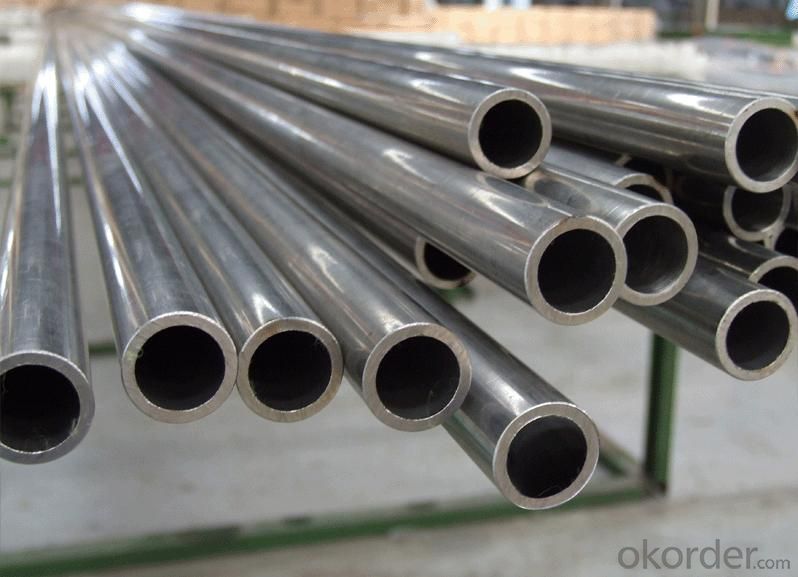
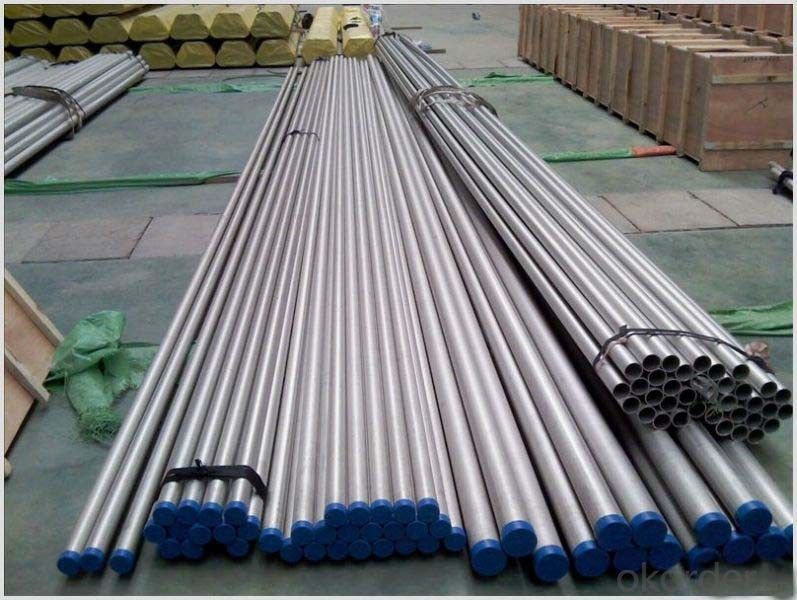
4、Heat Exchanger Stainless Steel Pipe TP316 ASTM A213 Specification:
| Welded Stainless Steel Tube | |
| Material Grade | 304,304L,316 ,316L,321,310S,2205,904and so on. |
| Standard | ASTM A312, A554, A249, A269 and A270,ect |
| DIN 17456-85 , DIN 17458-85, DIN 17459-92,ect | |
| JIS G3446-1994, JIS G3448-1997, JIS G3459-1997, JIS G3463-1994,ect | |
| GB13296-1991, GB14975-2002, GB14976-2002,ect | |
| Outer Diameter | 13.7-2020mm |
| Thickness | 0.5-50mm |
| Length | 1m -12m or as customers' request |
| Polish | 180G, 320G, 400G Satin / Hairline |
| 400G, 500G, 600G or 800G Mirror finish | |
| Test | eddy current inspection, ultrasonic inspection, X-ray inspection, real-time imaging, hydrostatic test, spectral analysis, intergranular corrosion, water pressure test, and mechanical property testing facilities. |
| Payment | 1) by L/C at sight, |
| 2) 30% deposit, 70% balance before Shipping. | |
| Delivery time | 7 days if this goods is stock goods. |
| 25 days if this goods will be produced after order | |
| Validity | Valid time is 3 days for price usually. |
| Payment terms | FOB QINGDAO |
| MOQ | 1 ton |
| Capacity | 1000 ton per month |
| Certificate | ISO, SGS, and third part inspection |
| Applications | the products are widely used in chemical industry, condenser pipe, heat exchanger, petroleum, shipping military, environment protection, high temperature resistant, low temperature resistant, corrosion resistant and so on. |
| packing details | 1) Wooden-box Package 2) The Wooden Frame Packing. 3) Intertexture Cloth Packaging with the Iron Sheet Bonding and the Two Terminals Covered With Plastic Dome. |
5、FAQ of Heat Exchanger Stainless Steel Pipe TP316 ASTM A213:
①How is the quality of your products?
Our products are manufactured strictly according to national and internaional standard, and we take a test on every pipe before delivered out. If you want see our quality certifications and all kinds of testing report, please just ask us for it.
Guaranteed: If products’ quality don’t accord to discription as we give or the promise before you place order, we promise 100% refund.
②How about price?
Yes, we are factory and be able to give you lowest price below market one, and we have a policy that “ for saving time and absolutely honest business attitude, we quote as lowest as possible for any customer, and discount can be given according to quantity”,if you like bargain and factory price is not low enough as you think, just don’t waste your time.Please trust the quotation we would give you, it is professional one.
③Why should you chose us?
Chose happens because of quality, then price, We can give you both.Additionally, we can also offer professional products inquiry, products knowledge train(for agents), smooth goods delivery, exellent customer solution proposals.Our service formula: good quality+good price+good service=customer’s trust
SGS test is available, customer inspection before shipping is welcome, third party inspection is no problem.
Any question, pls feel free to contact us !
- Q: How do you test the quality of stainless steel pipes?
- To test the quality of stainless steel pipes, several methods can be used. 1. Visual Inspection: The first step is to visually inspect the pipes for any visible defects such as cracks, dents, or surface irregularities. This can be done by simply observing the pipes closely and checking for any abnormalities. 2. Dimensional Inspection: The dimensions of the stainless steel pipes should meet the specified requirements. This involves measuring the outer diameter, inner diameter, wall thickness, and length of the pipes using calibrated measuring instruments such as calipers or micrometers. 3. Chemical Composition Analysis: Stainless steel pipes should have a specific chemical composition to ensure corrosion resistance and durability. This can be determined by conducting a chemical composition analysis, which involves using techniques like spectroscopy or wet chemical analysis to check the presence and percentage of different elements in the steel. 4. Mechanical Properties Testing: Mechanical properties such as tensile strength, yield strength, and elongation are crucial indicators of the quality of stainless steel pipes. These properties can be tested through various methods including tensile testing, hardness testing, impact testing, or bending testing. These tests are performed according to relevant industry standards to ensure the pipes meet the required mechanical specifications. 5. Non-destructive Testing: Non-destructive testing methods like ultrasonic testing, X-ray inspection, or electromagnetic testing can be employed to detect any hidden defects or inconsistencies within the stainless steel pipes without causing any damage. These tests are useful in identifying flaws such as cracks, voids, or inclusions that may compromise the quality and performance of the pipes. 6. Corrosion Resistance Testing: Stainless steel pipes are known for their excellent corrosion resistance. To verify their resistance to corrosion, various tests like salt spray testing or exposure to harsh environments can be conducted. These tests simulate real-life conditions to evaluate the pipes' ability to resist corrosion and ensure their long-term durability. It is important to note that the specific testing methods and standards may vary depending on the industry or application requirements. Therefore, it is essential to refer to relevant standards and specifications while conducting quality tests on stainless steel pipes.
- Q: Can stainless steel pipes be used in the aerospace industry?
- Yes, stainless steel pipes can be used in the aerospace industry. Stainless steel is known for its high strength, corrosion resistance, and durability, making it suitable for various applications in aerospace such as fuel systems, hydraulic systems, and exhaust systems. Its ability to withstand extreme temperatures and pressure fluctuations makes it an ideal choice for aerospace engineering. Additionally, stainless steel's lightweight nature contributes to fuel efficiency and enhances overall performance in the aerospace industry.
- Q: What are the different types of stainless steel pipe couplings?
- There are several different types of stainless steel pipe couplings available in the market, each offering unique features and functionalities. Some of the common types include: 1. Compression couplings: These couplings are designed to provide a tight and secure connection by compressing the pipe ends together using a compression nut. They are easy to install and suitable for both rigid and flexible pipe systems. 2. Flanged couplings: These couplings have flanges on both ends, which can be bolted together to create a strong and leak-proof connection. Flanged couplings are commonly used in industrial applications where high pressures and temperatures are involved. 3. Grooved couplings: These couplings consist of two segments that grip the pipe ends when tightened, creating a reliable and flexible connection. They are often used in fire protection systems and HVAC applications due to their ease of installation and ability to withstand vibration and movement. 4. Threaded couplings: As the name suggests, these couplings have threads on the inside, allowing them to be screwed onto the pipe ends. They are commonly used in low-pressure applications and are easy to assemble and disassemble. 5. Quick connect couplings: These couplings feature a quick-connect mechanism that allows for easy and rapid installation without the need for tools or additional components. They are often used in plumbing and irrigation systems. 6. Welded couplings: These couplings require the pipe ends to be welded together to create a permanent and robust connection. They are commonly used in high-pressure and high-temperature applications where a strong joint is essential. It is important to select the appropriate type of stainless steel pipe coupling based on the specific requirements of the application, such as the operating conditions, pipe material, and system design. Consulting with a professional or referring to industry standards can help ensure the right choice is made.
- Q: Are stainless steel pipes suitable for sewage treatment plants?
- Yes, stainless steel pipes are suitable for sewage treatment plants. They are highly resistant to corrosion and can withstand the harsh conditions and chemicals present in sewage treatment facilities. Additionally, stainless steel pipes are durable, long-lasting, and provide excellent hygiene and cleanliness, making them an ideal choice for sewage treatment plants.
- Q: Can stainless steel pipes be used for drinking water supply?
- Yes, stainless steel pipes can be used for drinking water supply. Stainless steel is a highly durable and corrosion-resistant material, making it a suitable choice for transporting drinking water safely and hygienically. Unlike other materials, stainless steel pipes do not leach harmful chemicals or contaminants into the water, maintaining its quality and purity. Additionally, stainless steel pipes are resistant to bacterial growth, which further ensures the safety of the drinking water.
- Q: What is the difference between double random length and single random length stainless steel pipes?
- The difference between double random length and single random length stainless steel pipes lies in their respective dimensions and lengths. Double random length stainless steel pipes refer to pipes that are cut in random lengths twice the size of single random length pipes. Single random length stainless steel pipes, on the other hand, are cut in random lengths without any specific multiple. The purpose of using double random length pipes is to accommodate longer sections of piping in industries where longer lengths are required. These pipes are typically used in applications that involve high pressure or temperature, such as oil and gas pipelines or petrochemical plants. Single random length pipes, on the other hand, are more commonly used for general-purpose applications where shorter lengths are sufficient. They are often used in plumbing, HVAC systems, or in smaller industrial settings. In summary, the main difference between double random length and single random length stainless steel pipes is the length of the pipes. Double random length pipes are twice as long as single random length pipes and are used in industries that require longer sections of piping, while single random length pipes are more commonly used for general-purpose applications.
- Q: What is the tensile strength of stainless steel pipes?
- The tensile strength of stainless steel pipes can vary depending on the specific grade and manufacturing process, but it typically ranges from 515 to 827 megapascals (MPa) or 74,800 to 119,900 pounds per square inch (psi).
- Q: Are stainless steel pipes resistant to fire?
- Indeed, stainless steel pipes possess remarkable fire resistance. Renowned for its exceptional heat-resistant qualities, stainless steel emerges as an appropriate material for situations involving elevated temperatures. In the face of fire, stainless steel pipes maintain their robustness and structural stability, thereby reducing the potential for collapse or malfunction. This fire resistance stems from the elevated melting point of stainless steel, which enables it to endure temperatures surpassing those commonly encountered in fires. Moreover, stainless steel does not fuel the propagation of flames, rendering it a secure option for fire protection and containment systems.
- Q: Are stainless steel pipes suitable for food processing plants?
- Yes, stainless steel pipes are highly suitable for food processing plants. Stainless steel is a commonly used material in the food industry due to its numerous beneficial properties. Firstly, stainless steel pipes are resistant to corrosion, which is crucial in an environment where food products are processed. Corrosion can contaminate food and compromise its safety, but stainless steel pipes are resistant to rust and other forms of corrosion, ensuring the integrity of the food being processed. Secondly, stainless steel pipes are easy to clean and maintain. The smooth surface of stainless steel pipes prevents the accumulation of food particles and bacteria, making them hygienic and easy to sanitize. This is particularly important in food processing plants where cleanliness and food safety are of utmost importance. Additionally, stainless steel is a non-reactive material, meaning it does not leach any harmful substances into the food being processed. This ensures that the quality and taste of the food are not affected by the piping material. Furthermore, stainless steel pipes have excellent heat resistance, allowing them to withstand high temperatures without warping or deforming. This makes them suitable for various food processing operations that involve heat, such as pasteurization or sterilization. In summary, stainless steel pipes are highly suitable for food processing plants due to their corrosion resistance, ease of cleaning, non-reactivity, and heat resistance. They contribute to maintaining the safety, hygiene, and quality standards required in the food industry.
- Q: Do stainless steel pipes require insulation?
- Yes, stainless steel pipes require insulation. Insulation helps to prevent heat loss or gain, reduces condensation, and maintains the temperature of the fluid inside the pipes.
Send your message to us
Heat Exchanger Stainless Steel Pipe TP316 ASTM A213
- Loading Port:
- Ningbo
- Payment Terms:
- TT OR LC
- Min Order Qty:
- 1 m.t.
- Supply Capability:
- 5000 m.t./month
OKorder Service Pledge
OKorder Financial Service
Similar products
Hot products
Hot Searches
Related keywords
